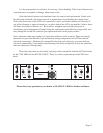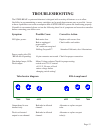FEATURES AND APPLICATIONS
1. HIGH PERFORMANCE FRONT END
The STEELHEAD preamplifier makes the best use of active and passive component and
circuit developments generated over the past half-century. The hybrid cascode gain blocks
simultaneously deliver wide-band high-gain, low noise and low distortion performance without
having to resort to heavy-handed amounts of negative feedback. Or overly complex circuit
topology. The multiplicative aspect of the cascoded device’s output (anode) impedance means that
the most important characteristics of each gain stage are preserved even though the local negative
feedback present in each block is very small. This approach makes the amplification factor of each
stage insensitive to tube gain or transconductance variations which occur due to device production
tolerance allowances or aging.
Other uncommon traits include high quiescent and operating current in each gain stage. This
lowers the static and dynamic impedances found within each stage and raises system bandwidth.
Musical material which would cause a cave-in of the typical current-starved 12AX7-based
preamplifier circuit are conveyed unflinchingly by these amplifier stages.
2. ACCURATE “4-CORNER” RIAA EQUALIZATION
In the spirit of high fidelity, all four RIAA phono equalization corner frequencies or time
constants have been specifically addressed in the STEELHEAD preamplifier. Historically most
designs have concentrated on the “big three” time constants of 3180, 318 and 75 microseconds.
This ignores the fourth corner of about 3.2 us, which when ignored causes most phono stages to
continue rolling off the highest octave signals coming from the phono pickup, rather than turning
the final “corner” and shelving to flat response at about 50 kHz. Careless removal of upper octave
bandwidth causes the recovered audio to become somewhat lifeless and remote, with needless loss
of impact, detail and percussiveness. Ironically this signal content is precisely what is omitted from
all currently popular digital audio delivery formats, and is one of the chief culprits behind the
homogenous upper octave sonic characteristics of those formats.
As with all equalizing amplifiers intended to correct a given form of frequency-selective
emphasis curve, care must be used when building the restorative compensation networks. Great
care must be exercised if the goal is to produce a highly accurate passive network coupled to low-
feedback amplifiers. And experience has shown that the effort spent in faithfully adhering to the
inverse RIAA equalization curve produces results that easily justify the additional procurement and
manufacturing costs. To this end, only hand-selected and/or1% tolerance components are used
throughout the RIAA equalization network. Add to that the factory-set variable capacitors, and the
result is very high equalization accuracy where small component and circuit layout variations that
other manufacturers ignore are netted out. This yields impeccable inter-channel phase and gain
matching at any gain setting. In short, the STEELHEAD will magnify the differences in the
character and personality of your vinyl recording collection, cartridge, tonearm and turntable. A
microscope for the ear! Be prepared to hear previously undiscovered musical content as you play
back your favorites!
Page 5


















